By: Marlena Jareaux
If you’ve ever seen mention of the Civil War Trails historical marker at Oakland Manor (near the Columbia Mall, installed in 2005) on the internet, you will have read about George R. Gaither (both father and son) and the Howard Dragoons. According to the sign, the Howard Dragoons (the local militia) learned mounted combat skills there at the Manor and then demonstrated them periodically for the residents of Ellicott’s Mills. Keep in mind, there were about 175 Free Black and Mulatto residents in Ellicott’s Mills, along with many being enslaved in 1860. See the following 1860 data post to get a better idea of the area at the time by clicking HERE What a sight and demonstration of power that must have been for everyone to see, free and enslaved.
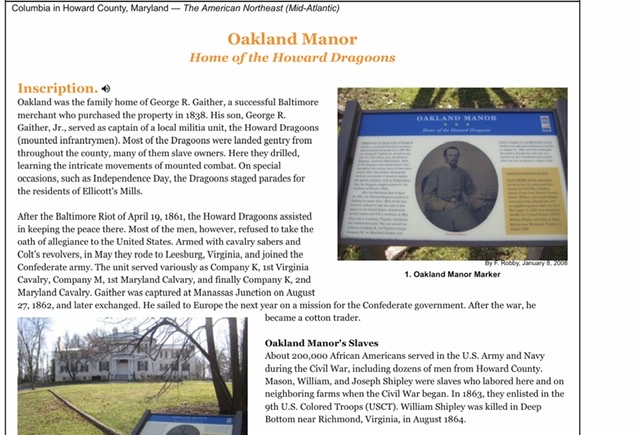
The marker also references the Shipley brothers: it has the names Mason, Joseph and William on it. For this story, the name Moses will be used instead of Mason. A “Mason” Shipley living in the 1800s could not be located in FamilySearch.org records, but “Moses” was, and that was the name he, the military and his family called him. Other inaccuracies will also be cleared up while telling the story of Joseph.
Joseph had 8 siblings total, and he had been named after his father, therefore making him “Jr. “ since his father was still alive. His parents were Joseph and Caroline Shipley. Joseph Sr was recorded as being 45 years old and Free, affiliated with the Stephen Anderson household in the Lisbon area for the 1860 census. He may have also been the Joseph Shipley who was recorded to be a free Black male living on a farm in Montgomery County the decade before. He possibly moved to Howard County from Montgomery. Caroline could not be located in the records prior to the Civil War. Likely, she was being enslaved by someone while awaiting her freedom since record of her sons being enslaved exist.
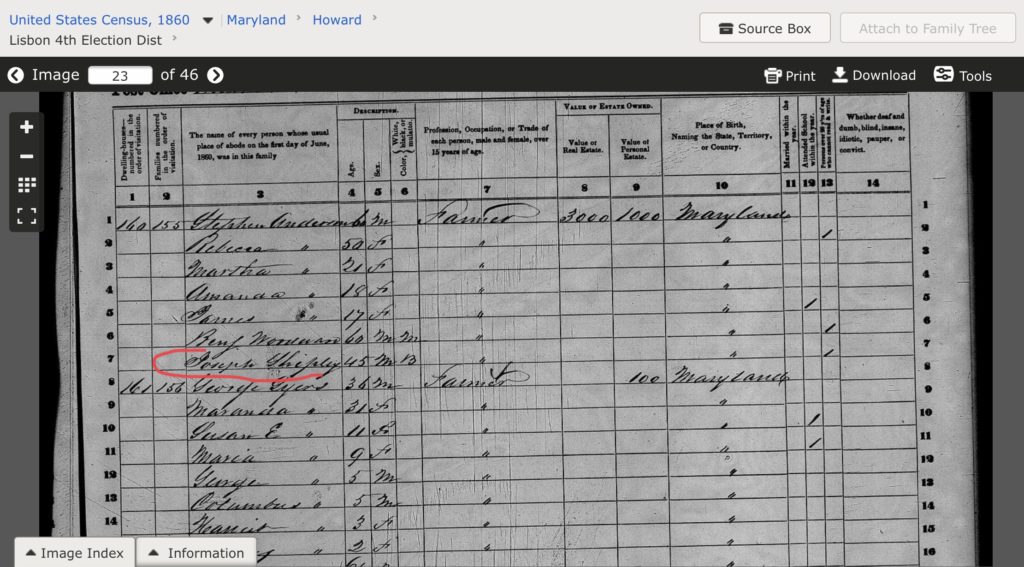
The Civil War did some interesting and unfortunate things to this family. That’s not to imply that they were the only ones, of course. The record that exists for this particular family provides a compelling story about a Civil War veteran his family and the community that isn’t often found for an African American of that time period. This story is being placed onto this website for reasons that will become clear at the end. This story also reveals many of the intricacies involved in tracing stories like Joseph’s.
Imagine that you’re a male and your father is free, but you are not. Even if it’s all you’ve known, even if you know your day to be free is possibly coming (and I don’t know if Joseph or his brothers thought they would be freed by their enslaver), you see your father having mobility that you don’t have. Abraham Lincoln was elected President, but where you live in Howard County, only ONE voter had cast a vote for him. Alabama, SC, Florida, Louisiana, Georgia, Miss., and Texas have seceded from the Union and formed the Confederate States of America before Lincoln was even inaugurated on March 4, 1861. An untold number of Howard County residents attended a secession rally at Clarksville on April 22, 1861, and the Howard Dragoons were formed to support the Confederacy. Four more states seceded by May, including nearby Virginia. There is much that has already been written about the draft in Howard County, but the 1st draft wasn’t applicable to African Americans, so it will be largely skipped here. It will be noted however that due to significant delays in the county in fulfilling its quota as well as the destruction of enrollment records and the resignation of enrollment officers, the first HoCo draft for Union soldiers didn’t happen until January 24, 1863 in Ellicott’s Mills. This is from info published by the Howard County Genealogical Society on the enrollment and 1st draft.
The story now turns back to the Shipley brothers. Where were they when this was going on? The Baltimore jail. “Why” has an interesting answer. The navy had remained racially integrated, even after the army had excluded Black men with the federal Militia Act in 1792. After the Battle of Fort Sumter, Black men began enlisting in increasing numbers where they could. Some were running away in order to do it. William and Columbus Shipley ran away, and Moses must have been planning to do so also, though it may have been just to escape their enslavement. William and Columbus were committed to the jail in Baltimore City on February 22, 1862 as runaways. Moses was already there ahead of them, having been placed there for what was called “Accommodation”. You were placed there to be held and confined, not charged with an crime. His enslaver, fearing he would run away to enlist, placed him there. Who placed him there, and who sought the return of William and Columbus Shipley?
Emily and Charles Carroll MacTavish. She had been the favorite granddaughter of Charles Carroll of Carrollton (last living signer of the Declaration of Independence), and Charles was her son.
Emily died in 1867, and she and her husband had already given the property to CC MacTavish in 1850. The Maryland Historical Trust writeup for Carrollton Hall/Folly Quarter reports it was “sold” to him, but a $5 consideration amount in the chain of title is clearly the clerk’s transfer fee. Because he sold the property in 1864, it’s being included as possibly being a place where he/they had been enslaving William, Columbus and Moses. The state archives hold this material, and it’s reflected in the databases as shown below. Moses was referred to as an apprentice, which is important because that phrase means he possibly was not a slave. He had a time of servitude, and someone hired him out to MacTavish.


This story was larger than originally contemplated, so the tracing for who did what and when with the MacTavish family will possibly be fleshed out further another time. For this story, it’s important that the reader know that on October 1, 1863, the War Department issued General Order 329 in order to recruit Free Blacks and the enslaved of loyal Marylanders. A $300 bounty would be given to enslavers who released those they were enslaving in order to serve. Moses was released from jail by the General listed in the picture above on November 24, 1863. Yes, MacTavish apparently left him in there for 1 year, 9 months and 3 days. On that day, all 3 brothers were recruited by the General, and all 3 brothers got credited to the same Company (K) of the 9th Infantry of the US Colored Troops. Moses was 25 (listed as a sailor), Joseph was 24 (farmer), and William was 18 (engineer). They were all credited to the Carroll County rolls, so they’d meet their enlistment numbers.
Joseph would get credited with 2 years, 8 months, and 27 days of pensionable service. He was discharged November 26, 1866 in New Orleans. Moses got discharged the same date, also from New Orleans. They were leaving to go home without their younger brother William, who was killed in action on August 16, 1864 at Deep Bottom, VA.
It isn’t precisely known when the brothers got back to Maryland. Joseph Jr. was recorded as being a waiter at the end of 1869 for a Freedman’s Bureau bank account but no one was listed as family in the record. His brother Moses listed what appears to be the same address as Joseph at the beginning of the same year for a back pay claim.


Joseph’s parents, Joseph and Caroline, had been taking care of their deceased son William’s final affairs with military death claims (pension) beginning in 1867.
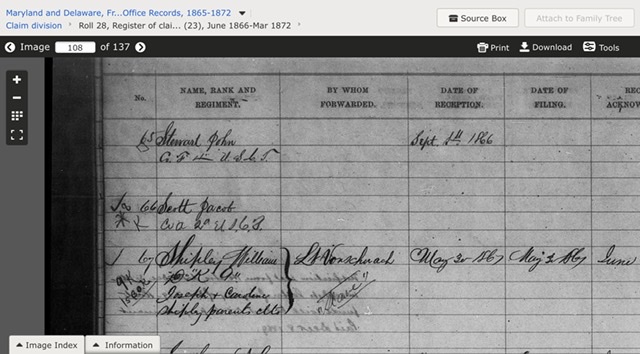
Moses was found on the 1870 census in Howard County’s District 6 with a woman named Sarah and someone’s son who had been named William Shipley. Moses did have a sister named Sarah. The household was recorded to have been visited by the census taker right before going to the next residence: that of Arthur P. Gorman’s mother, Elizabeth. Gorman had been elected Maryland Delegate in 1869.
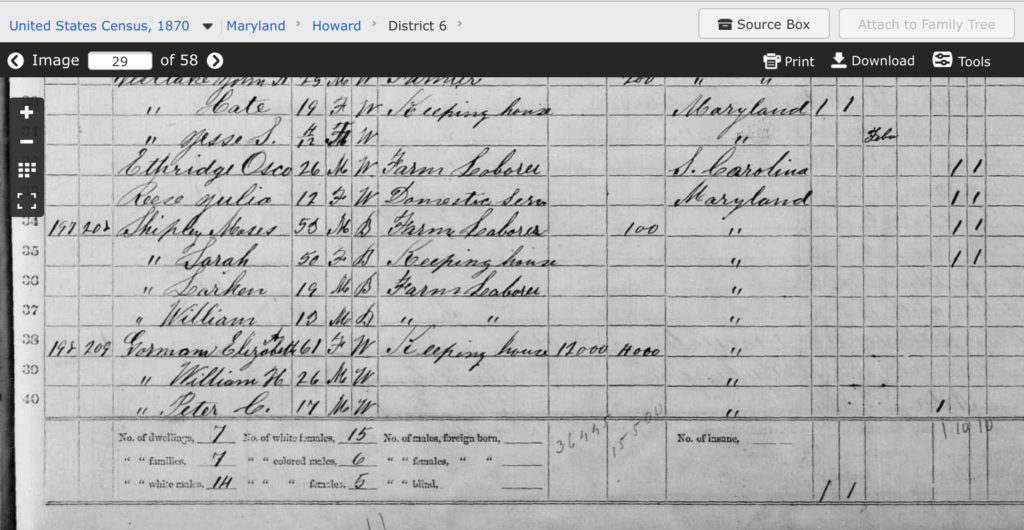
Joseph Jr was not doing well. In depositions, neighbors, family and Company K members reported the following:
- “..his mind was sound before his enlistment” – Mary Robinson
- knew him since his childhood. “..when he came home from the army..he was clearly suffering from mental trouble.” – Ellen Reynolds
- “He would fight his mother + would become so violent” – Ellen Reynolds
- ”..began to lose his mind + continued to get worse very rapidly” William Hampden from Company K
- “..after his discharge..he had a green corn on his shoulders and was going through the drill maneuvers..” – Moses Joyce
- ”Was walking up and down the street shooting with sticks running up and down imagining he was in the army.” “..about a month after his discharge he attacked his brother and inflicted a permanent scar which will last for his life. Very soon after this he shot at his mother.” – Moses Steward, knew him from boyhood.
- “We all come from the same place in Howard Co- from the Carroll family- but do not claim any relationship.” – Ellen Reynolds
- “..was always known as a quiet steady young man before going into service- before enlistment his owners kept him and the other brothers in confinement to prevent their running away and joining the army. The McTavish family were then owners of the soldier and his brothers.” – Mary Robinson
- ”we were all living in Howard County before the war. We were all owned by the same party Carroll McTavish…there were 8 children of us all by same mother..” Sarah Shipley, sister
- others said they saw no issues with Joseph while he was in Company K.
The purpose of the depositions was to get and maintain an Invalid Pension to assist in getting some care for Joseph so he would not harm himself or others. The reader can view the complete written depositions for themselves in the linked file found at the bottom of this page. It was a continuing process that had to periodically got renewed, and it was getting challenged as you can read. A few things are going to be emphasized here by using a few of the file images.
The reason Joseph Jr. is included on this website is because the story was: he burned down Senator Gorman’s barn. He was sent to the jail at Ellicott Mill’s, and was ultimately sent to an asylum.
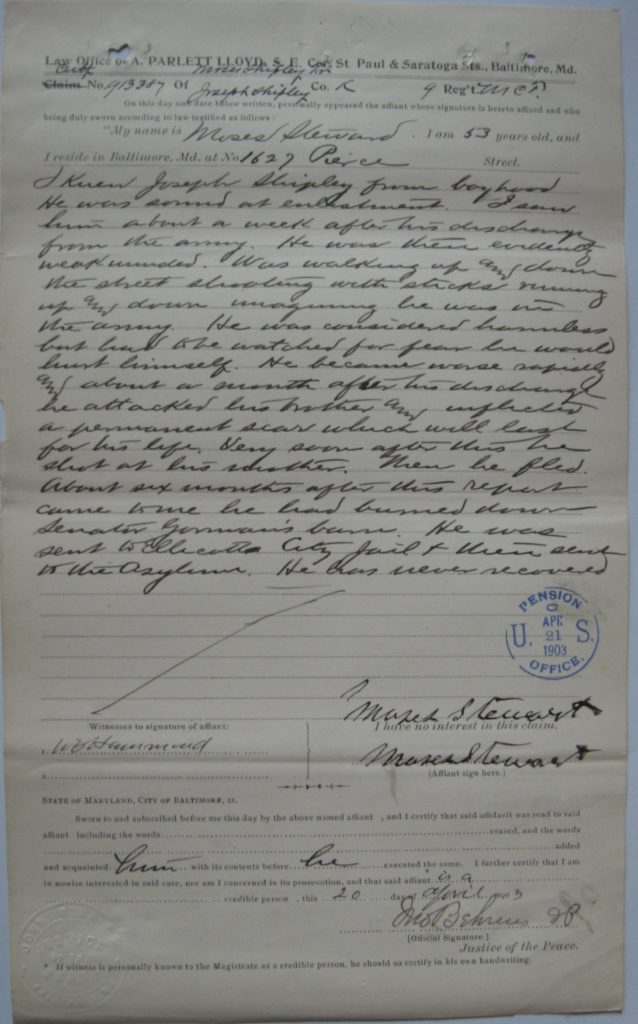
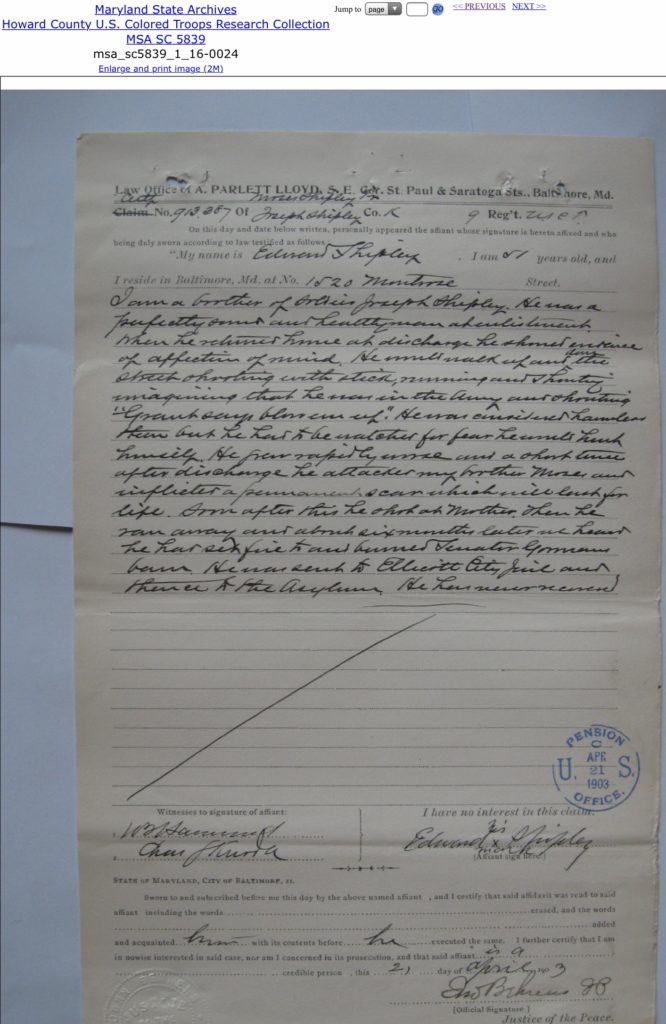
Here’s one document regarding an admission date for Joseph (though the depositions indicate there was more than one admission):
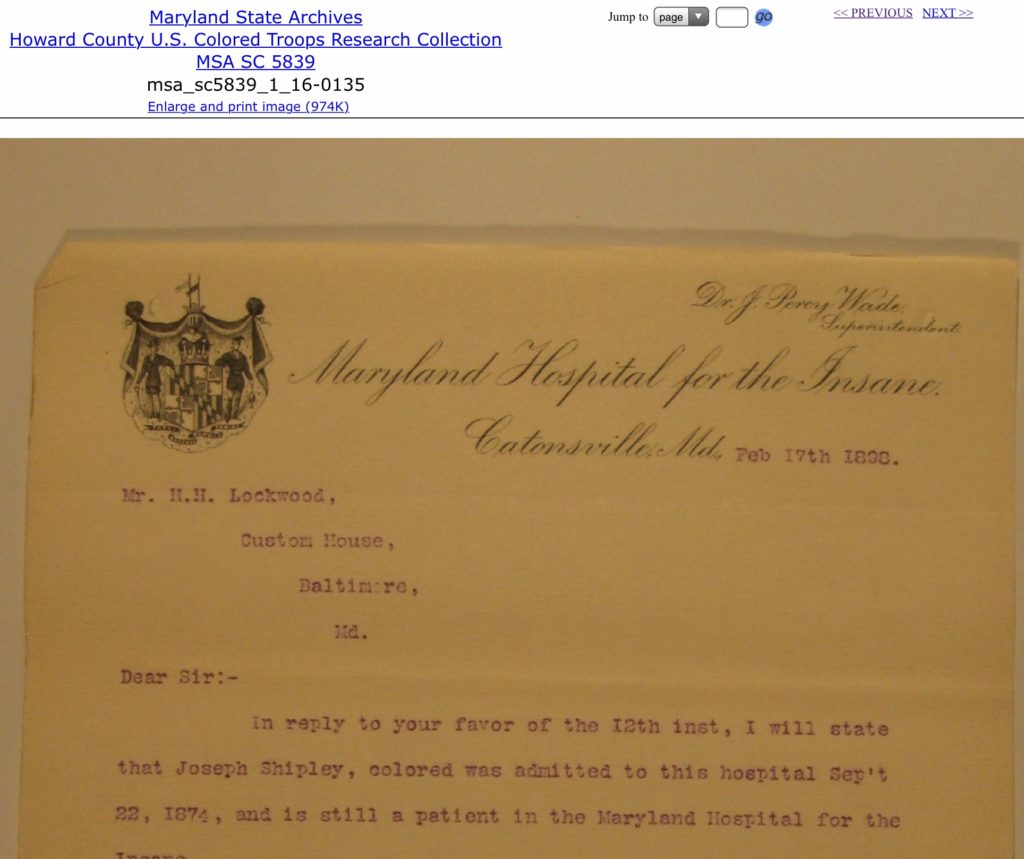
Barn burning was a serious thing in those days, and one could easily be sent to the penitentiary for 20 years if charged, tried and convicted of doing it. Tempers would apparently flare after a barn or dwelling burning, because his sister stated that “..the people there were about to lynch him..” but instead he got sent to Spring Grove.
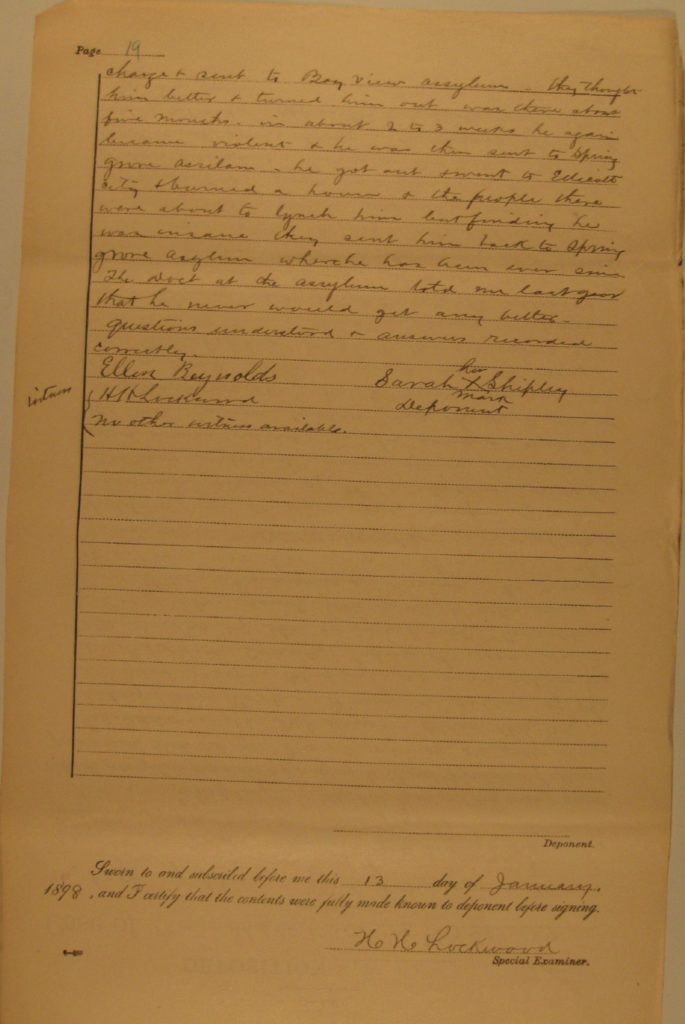
Joseph’s siblings would each take turns being Trustee for his care (a process done in Howard County’s Circuit Court), as each of the siblings would eventually die. First, Moses, then Sarah (sister), then Edward (brother) and then Justina (sister). She was Trustee in 1921.

Joseph Shipley, Jr. died on September 19, 1928 at Crownsville State Hospital. He was nearly 90 years old. Unfortunately no photo of him could be located, but a description of him exists: 5’9” male mulatto with black hair and greyish eyes.

In modern times, we know about the existence of Post Traumatic Stress Disorder. Particularly with veterans. Joseph’s case is fascinating in that it showcases the process of a veteran claim as well as the family involvement in that process. There is a lot that can be unpacked with this story. Today, we know to be compassionate with veterans who see combat. Did the death of Joseph’s brother during the war impact him? Did he see something, since they were in the same company? One of the people from his company talked about seeing Joseph fall down while they did a “double-quick” and a third of the company essentially trampling over him. Did that affect him? You’ll read that by June 19, 1893, a statement was written that “This claimant is so disabled from insanity as to be incapacitated in a degree equivalent to the loss of a hand or foot for the purposes of manual labor.” Joseph was lucky he got help.
Moses was reporting to be married by the 1880 census, but had moved out of Howard County. He, his wife Emma, and their 3 kids were living on Eutaw Street in Baltimore. They named their oldest son William.
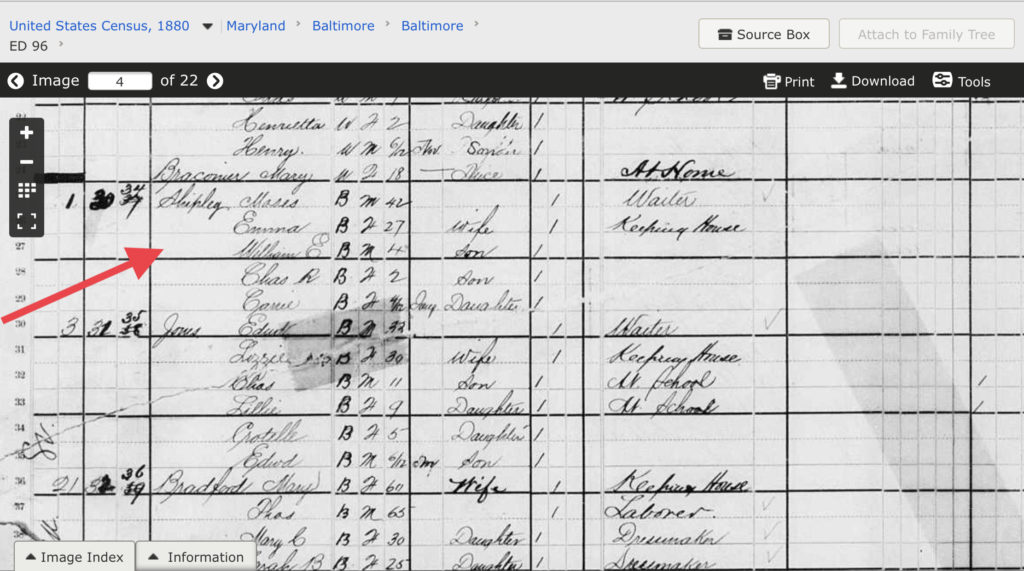
The MacTavishes? Both Emily and her son Charles wasted no time making claims with the Slave Claims Commission to attempt to be financially compensated for the value of the loss of 2 of the Shipley vets. As you’ll see, Emily attempted to claim for William (claim #1186), while Charles attempted to claim for Moses (claim #1185). Having sold his Howard County residence in 1864, he listed Baltimore City as his residence as did Emily.

Compensation wasn’t recorded as being paid to either of them, but there wasn’t an entry noting that a refusal happened. A letter was mailed to them in 1865. Deeds of manumission freeing the enslaved was to accompany the claims.

There is no doubt that it was just as the Shipley family had said. An agent for MacTavish had requested info from the Board of Claims about doing the claims and referenced 3 enslaved men taken from the Baltimore jail.
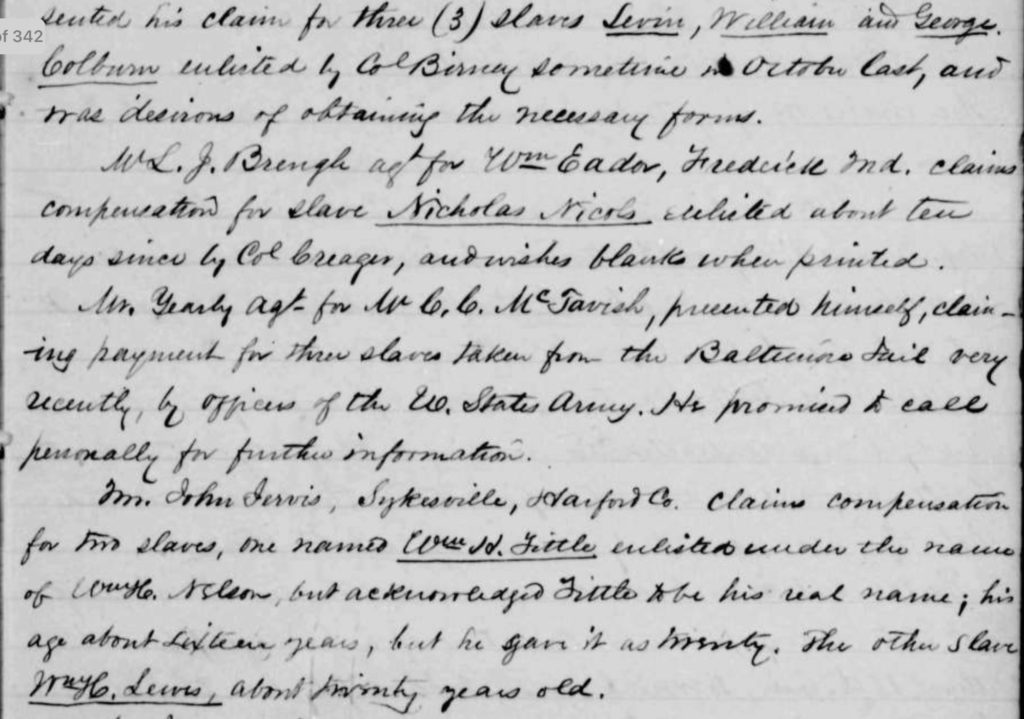
Emily MacTavish died in 1867. There were some interesting twists to the story. This is part of the advertised draft notice May 23, 1864 (The Sun). His name didn’t appear originally on the county enrollment record for eligible men. He evidently didn’t go, likely due to age ineligibility (had to be 18-45). His son bearing the same name was only 7, so it was the father’s name. Ironic that he had been drafted along with some he had been enslaving! That’s a larger story that will one day be expanded upon. Charles Carroll MacTavish Sr. died in 1868.
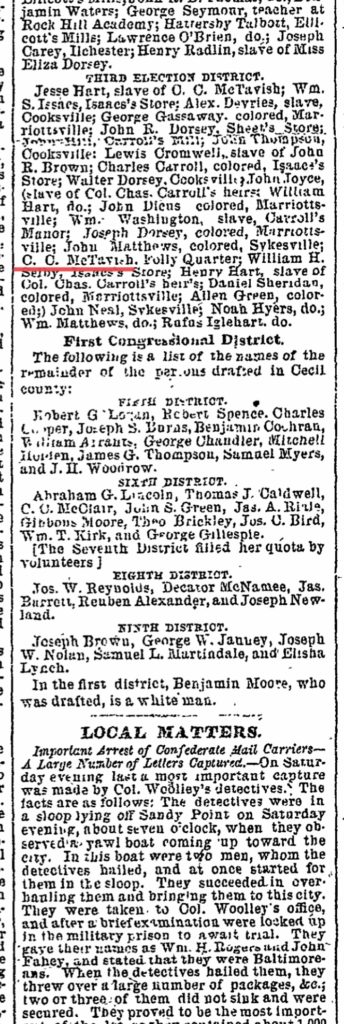
Joseph Jr. would have been drafted to fight for the Union anyway. On May 24, 1864 his name was published on the draft list, as a slave of Gaither’s. If records exist that tell the truth about who was the enslaver of Joseph with the right to make a financial claim, or a claim, this site will get updated with it. The draft person for that District was the one who placed his name and that info on the draft, and may not have known precisely.

And on September 24, 1864 when yet more men were needed for the war, the draft list included Joseph’s dad who was residing in District 4. He was age ineligible also, just as the enslaver of his sons (MacTavish) was.
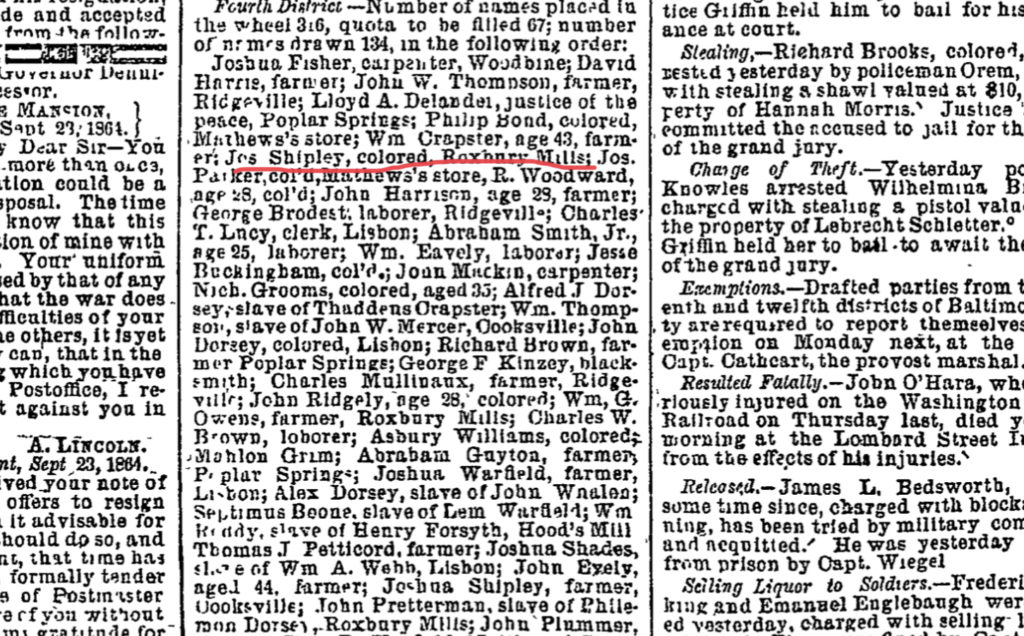
Elizabeth A. Gorman, who had been living near Moses Shipley (and possibly Joseph if he spent time with them), indicated her desire to be financially compensated for the loss of the value of those she had been enslaving. One was a 14 year old girl who also had the last name Shipley who had 11 years left of her servitude. She was possibly the reason Moses Shipley came to reside nearby. In 1860, Maria Shipley was recorded as being a Free Black head of her household residing near Arthur, and his parents Peter and Elizabeth Gorman. Airey was maybe her child, related to Moses and Joseph. Elizabeth Gorman died in 1886.

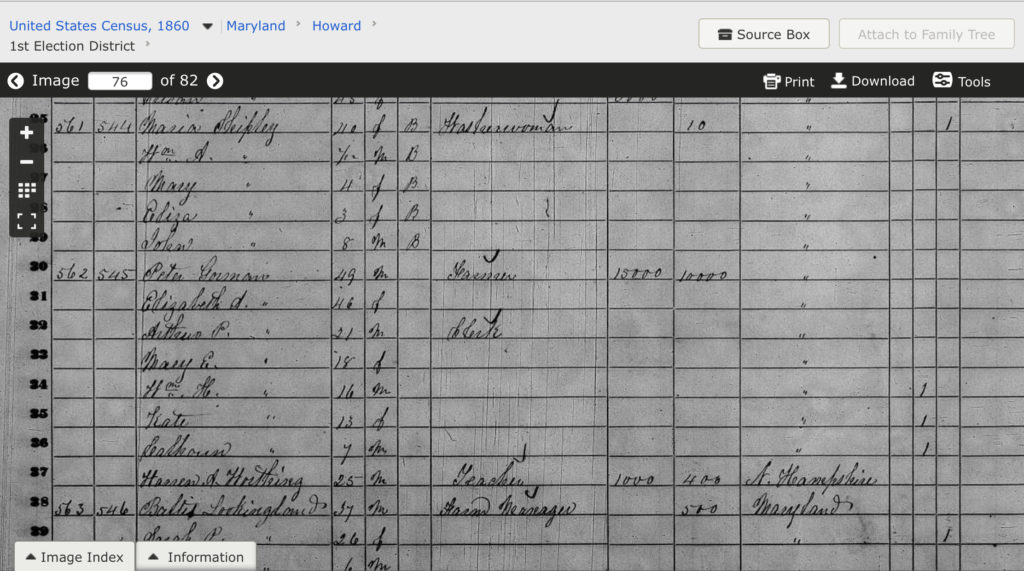
Caroline and Joseph Shipley, Sr had been living in Baltimore by 1870 with their children Sarah, Edward and Justine while much of this was going on with Joseph Jr.
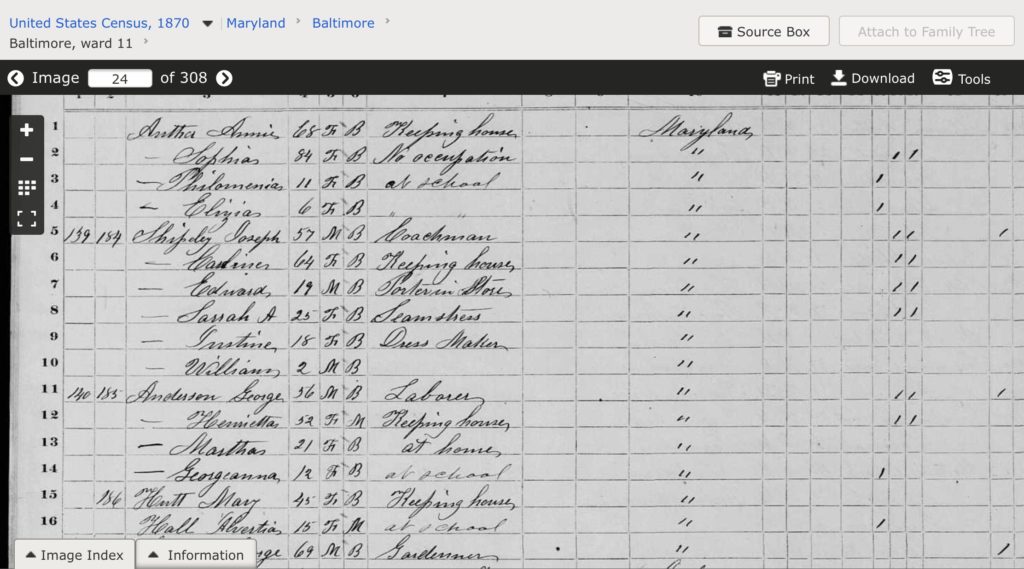
*In writing up this report, I came across something written by someone before me. She appears to have been a college student in 2018 from Howard County. When I read it, I knew the story of the Shipley brothers would need to be done differently than I had originally planned, for people like Annika. And perhaps someone like her will carry the torch further and fill in gaps I have surely left. That’s how I think history is supposed to work. Maybe someone will forward this to her so that she knows… I heard her?
The entire file for Joseph used for this can be found using the link below. Other sources were noted within this post.
http://mdhistory.msa.maryland.gov/msa_sc5839/msa_sc5839_31/html/msa_sc5839_1_16-0001.html
Source regarding the county enrollment and 1st draft: it’s on Amazon, but I prefer to send people directly to their site which is here
Joseph’s USCT record:
The current Civil War Trails sign was updated with the following language regarding the Shipleys. The change was brought about by the Howard County Center of African American Culture’s work (their museum is at Oakland Manor) with the Trails organization (who gave us permission to post part of the sign here).
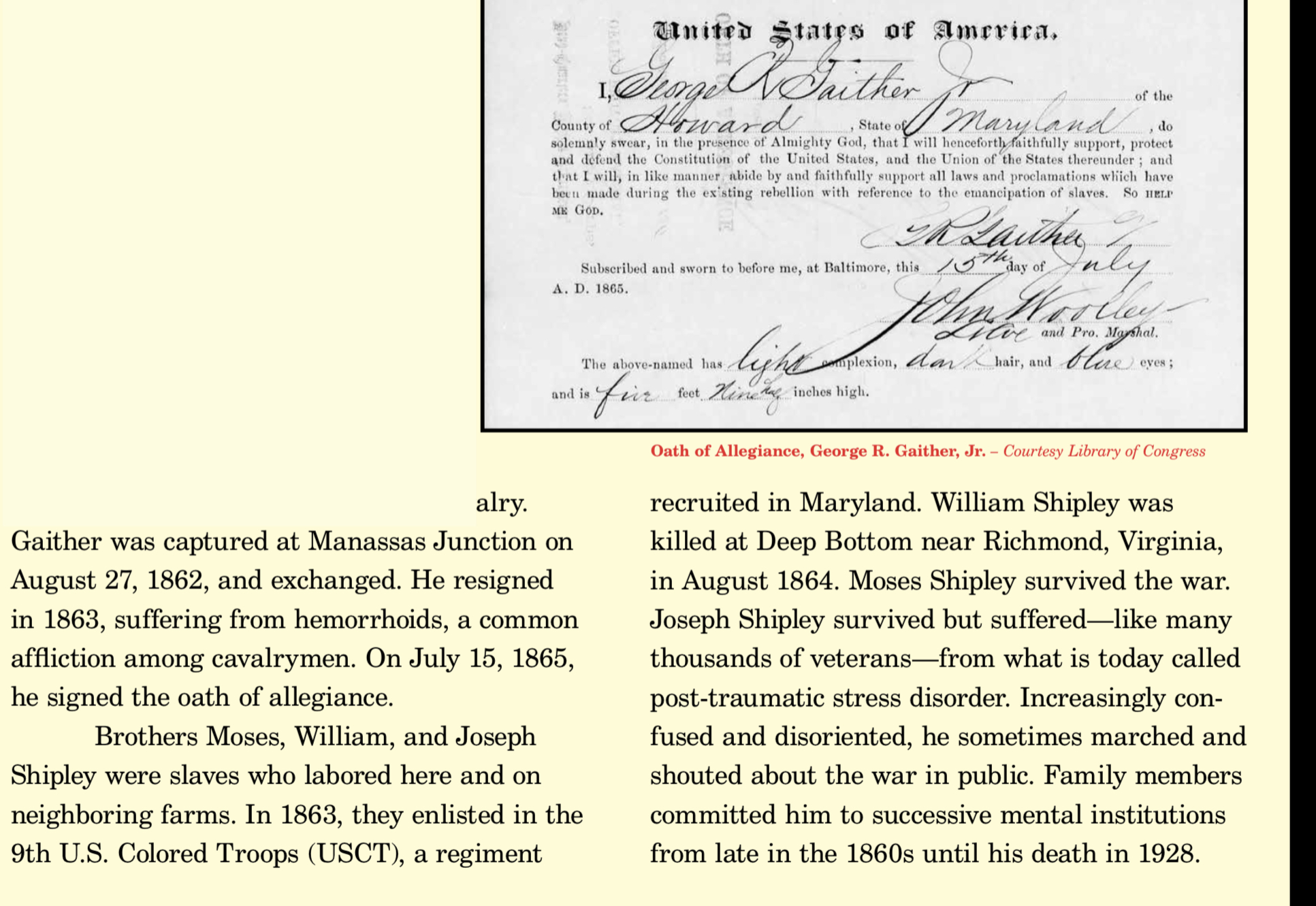
This isn’t Joseph, but it’s a representation of a USCT member just as Joseph was. A link to a group that did an exhibit on USCTs where this photo came from can be found below it:

